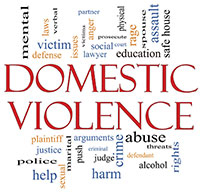 |
Moving from being in an abusive relationship to being out in the world is a dramatic life change. A change from both without and within. In the months before I left, I remember telling my counselor that I felt like I was going through a metamorphosis. I could feel a difference forming in my frame of mind, my understanding of myself and my perspective on my situation. I was the same person and yet I was different in what I could see, what I could understand, and what I could do. Much like changing from a caterpillar who cannot fly, into a butterfly. … Circle created for me a safe place where I was supported and encouraged. I was the only one that could do the work and make the process happen. Circle was there to support me and keep me safe both physically and emotionally during that precarious time.
|
That moving testimonial from a former shelter resident appeared in a 2016 newsletter of Circle, a community-based organization in Barre dedicated to ending domestic violence. It speaks volumes about the help Circle, and other organizations in Vermont, are providing for women who experience domestic and sexual violence. It also speaks poignantly to the myriad challenges women face as they find their way back to safety and self-directed lives.
 |
Just how bad is the problem of domestic and sexual violence in Vermont? A 2015 state report reveals that between 1994 and 2014, 50 percent of all Vermont homicides were domestic violence related. Five to 7 percent of those cases (among adults) involved firearms, and 51 percent of victims of domestic-violence-related fatalities were female. Of 15 homicides in Vermont in 2014, 10 were related to domestic violence. Three of those cases involved blunt trauma to children. Sadly, that year the number of people killed in a caregiver/child relationship exceeded the number killed in intimate partner relationships.
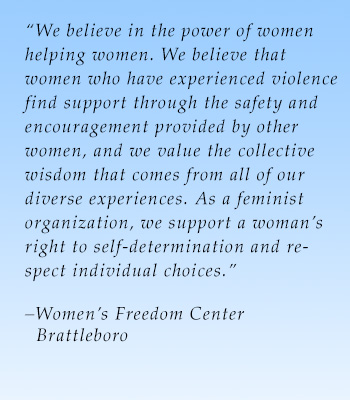 |
Vermont takes the problem seriously. The Office of the Attorney General has an attorney dedicated to working on issues of domestic violence with a focus on policy formation statewide. The attorney is also active on several committees and plays a role in legislative efforts, training—including police officers—and criminal justice issues. Despite some concern among advocates that the state tends to be more supportive of defendants than victims in some respects (e.g., granting shared custody or visitation despite acts of violence committed by the defendant), the state has demonstrated responsiveness to program needs, including providing financial support to programs even when Vermont is facing deficits.
A key organization in the work of addressing domestic and sexual violence is the Vermont Network Against Domestic and Sexual Violence. Committed to eradicating such violence through advocacy, empowerment, and social change, the Network is the federally recognized domestic and sexual violence coalition in Vermont.
|
It is a statewide resource on related issues, and its staff provide support for Network programs through training, technical assistance, and capacity building. It also advocates for public policy that supports victims, holds offenders accountable, and seeks to change societal attitudes and beliefs through community outreach and prevention. While the Network doesn’t provide direct services, it supports 14 member organizations that offer support, hotlines, legal and court assistance, help with basic needs or hospital visits, and shelter throughout Vermont.
Living Free of Violence
Circle, formerly formerly Battered Women’s Services and Shelter, is a Network member based in Barre, serving all of Washington County. Circle’s mission is to recognize that “women and children have the fundamental right to live in safety, free from all forms of intimate partner violence.” It supports those who access their services “as they explore their options. By building on the strengths of the individual, and through the collective voice of an aware community, together we seek to end domestic violence.”
To that end, Circle offers a 24-hour toll-free hotline, emergency shelter, legal advocacy, school programs aimed at prevention, and educational presentations on the dynamics of domestic violence and engages in community collaborations designed to “mobilize community awareness and sensitivity to issues relating to domestic violence.” |
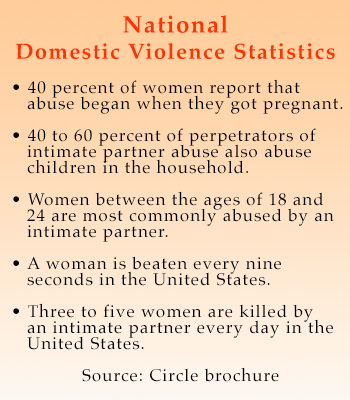
|
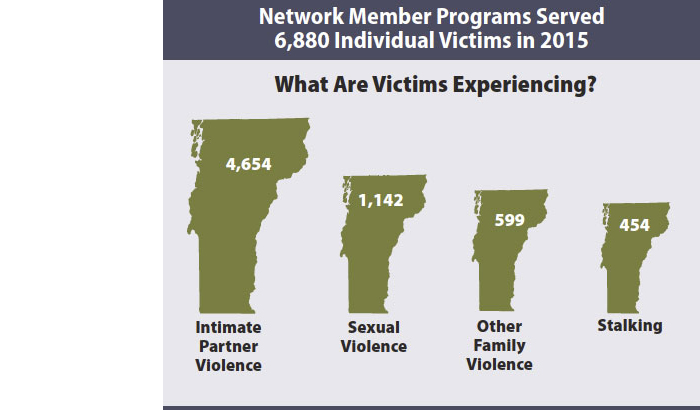

|
“Our staff is committed to finding a balance that allows us to meet families’ immediate needs while at the same time providing educational and awareness activities that will prevent future incidents of violence in our community. We believe that by offering diverse programming, we are better serving women and their children, and through community partnerships, we are also providing a wider range of services,” Diamond says.
In recent years Circle, like other organizations in the state that support victims of domestic and sexual violence, has seen an increased demand for their services, especially on their hotline and at their emergency shelter. In an average year, Circle helps victims and survivors file about 115 temporary Relief from Abuse orders, a number that has remained steady.
|
But the number of hotline calls have dramatically increased and now average about 430 calls per month. The shelter is also facing increasing numbers, both in terms of people calling for shelter and the number of nights people must stay in shelters due to lack of affordable or safe housing options.
Helping All Victims
Steps to End Domestic Violence, formerly known as Women Helping Battered Women, situated in Burlington and serving Chittenden County, is also seeing new types of demand for services. “Over the past few years, we’ve seen more male-identified victims come forward for help, as well as trans-identified individuals,” explains Executive Director Kelly Dougherty, who also cochairs the Vermont Network Board of Directors. “Part of the reason for our name change was to make our services more welcoming to those who don’t identify as women.”
Begun in 1974 by a group of volunteers who used their own homes to answer crisis calls and provide shelter, Steps to End Domestic Violence now provides a wide range of services through a staff of over 20 and a network of more than 190 volunteers. One of the more recent challenges they’ve faced, according to Dougherty, is finding permanent housing because “the rental housing market makes it challenging to find affordable housing.” She notes that “without landlord references or a stellar rental history, which can often be the case for those with whom we work because of the actions of their abusive partner, it is difficult to obtain permanent housing.”
Safe Housing
Safe, affordable housing is one of the issues the Women’s Freedom Center in Brattleboro faces on behalf of the women it serves as well, says Executive Director Vicky Sterling. The center has also seen an increase in the number of women struggling with opioid addiction, which has led the center to work on expanding its shelter capacity while enhancing in-house support offerings. |
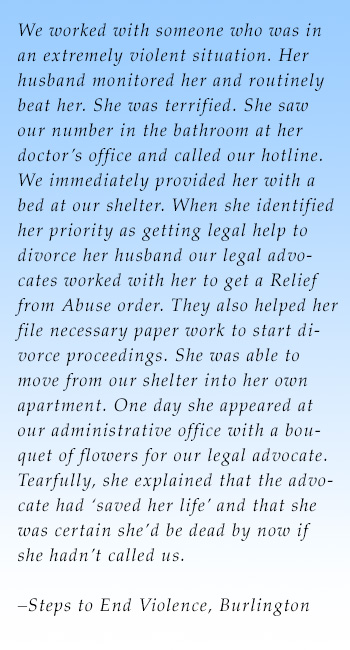 |
In addition, says Sterling, “the rural nature of our state is one of the most significant barriers for women experiencing violence. We would like to see increased local access to the legal system because many of the survivors with whom we work do not have transportation, which presents an enormous barrier to safety.”
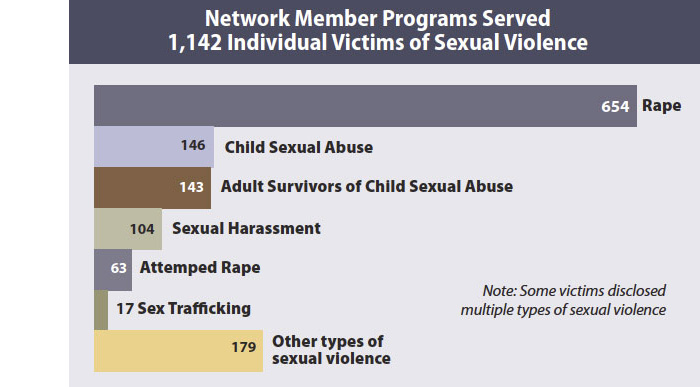
In addition to these kinds of concerns and the increased demand for services, the threat of severe federal funding cuts under a Trump administration is alarming all programs in Vermont, and elsewhere, that serve victims and survivors of domestic and sexual abuse. Many grant programs authorized through the Violence Against Women Act could be eliminated and anticipated cuts in other federal programs, including housing subsidies through the Department of Housing and Urban Development could have a tremendously negative impact, making increased private funding essential.
“Even without the current threats on the federal level,” Dougherty points out, “we are challenged by insufficient financial resources to assist those we serve. We operate on a shoestring. And we are consistently and severely challenged by merely balancing our agency budget every year in order to maintain staffing levels, and therefore, the level of services we provide.”
The complexity of domestic and sexual violence and its long-term impact can be difficult to understand. That’s why people often ask, “Why doesn’t she just leave?” That question fails to realize how difficult it can be to leave an abusive relationship. Most women who are murdered by their partners are killed when they attempt to leave. Economic abuse and hardships, threats of harm to children or pets, and control and coercion must be overcome. For those working to help victims and survivors, “seeing someone find safety and freedom is incredibly rewarding,” as Dougherty puts it. “Domestic violence is something people don’t like to think about or talk about, but it is happening, among all socioeconomic levels, ages, sexual orientations, and races. It does not discriminate. I hope people will learn more about the issue and why the services we all provide are so important, and often life-saving.” 
|







